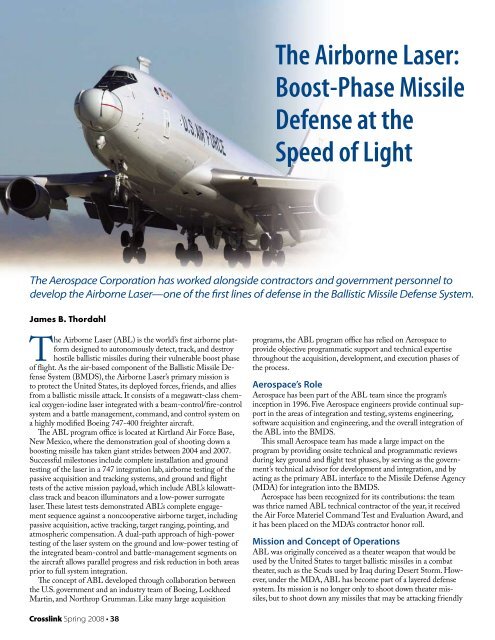Crosslink - Space-Library
Crosslink - Space-Library
Crosslink - Space-Library
You also want an ePaper? Increase the reach of your titles
YUMPU automatically turns print PDFs into web optimized ePapers that Google loves.
The Airborne Laser:<br />
Boost-Phase Missile<br />
Defense at the<br />
Speed of Light<br />
The Aerospace Corporation has worked alongside contractors and government personnel to<br />
develop the Airborne Laser—one of the first lines of defense in the Ballistic Missile Defense System.<br />
James B. Thordahl<br />
The Airborne Laser (ABL) is the world’s first airborne platform<br />
designed to autonomously detect, track, and destroy<br />
hostile ballistic missiles during their vulnerable boost phase<br />
of flight. As the air-based component of the Ballistic Missile Defense<br />
System (BMDS), the Airborne Laser’s primary mission is<br />
to protect the United States, its deployed forces, friends, and allies<br />
from a ballistic missile attack. It consists of a megawatt-class chemical<br />
oxygen-iodine laser integrated with a beam-control/fire-control<br />
system and a battle management, command, and control system on<br />
a highly modified Boeing 747-400 freighter aircraft.<br />
The ABL program office is located at Kirtland Air Force Base,<br />
New Mexico, where the demonstration goal of shooting down a<br />
boosting missile has taken giant strides between 2004 and 2007.<br />
Successful milestones include complete installation and ground<br />
testing of the laser in a 747 integration lab, airborne testing of the<br />
passive acquisition and tracking systems, and ground and flight<br />
tests of the active mission payload, which include ABL’s kilowattclass<br />
track and beacon illuminators and a low-power surrogate<br />
laser. These latest tests demonstrated ABL’s complete engagement<br />
sequence against a noncooperative airborne target, including<br />
passive acquisition, active tracking, target ranging, pointing, and<br />
atmospheric compensation. A dual-path approach of high-power<br />
testing of the laser system on the ground and low-power testing of<br />
the integrated beam-control and battle-management segments on<br />
the aircraft allows parallel progress and risk reduction in both areas<br />
prior to full system integration.<br />
The concept of ABL developed through collaboration between<br />
the U.S. government and an industry team of Boeing, Lockheed<br />
Martin, and Northrop Grumman. Like many large acquisition<br />
programs, the ABL program office has relied on Aerospace to<br />
provide objective programmatic support and technical expertise<br />
throughout the acquisition, development, and execution phases of<br />
the process.<br />
Aerospace’s Role<br />
Aerospace has been part of the ABL team since the program’s<br />
inception in 1996. Five Aerospace engineers provide continual support<br />
in the areas of integration and testing, systems engineering,<br />
software acquisition and engineering, and the overall integration of<br />
the ABL into the BMDS.<br />
This small Aerospace team has made a large impact on the<br />
program by providing onsite technical and programmatic reviews<br />
during key ground and flight test phases, by serving as the government’s<br />
technical advisor for development and integration, and by<br />
acting as the primary ABL interface to the Missile Defense Agency<br />
(MDA) for integration into the BMDS.<br />
Aerospace has been recognized for its contributions: the team<br />
was thrice named ABL technical contractor of the year, it received<br />
the Air Force Materiel Command Test and Evaluation Award, and<br />
it has been placed on the MDA’s contractor honor roll.<br />
Mission and Concept of Operations<br />
ABL was originally conceived as a theater weapon that would be<br />
used by the United States to target ballistic missiles in a combat<br />
theater, such as the Scuds used by Iraq during Desert Storm. However,<br />
under the MDA, ABL has become part of a layered defense<br />
system. Its mission is no longer only to shoot down theater missiles,<br />
but to shoot down any missiles that may be attacking friendly<br />
<strong>Crosslink</strong> Spring 2008 • 38
















